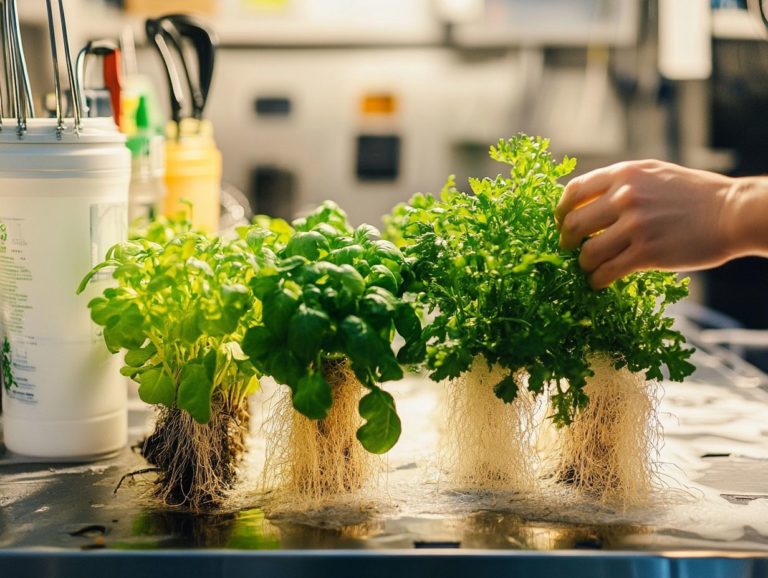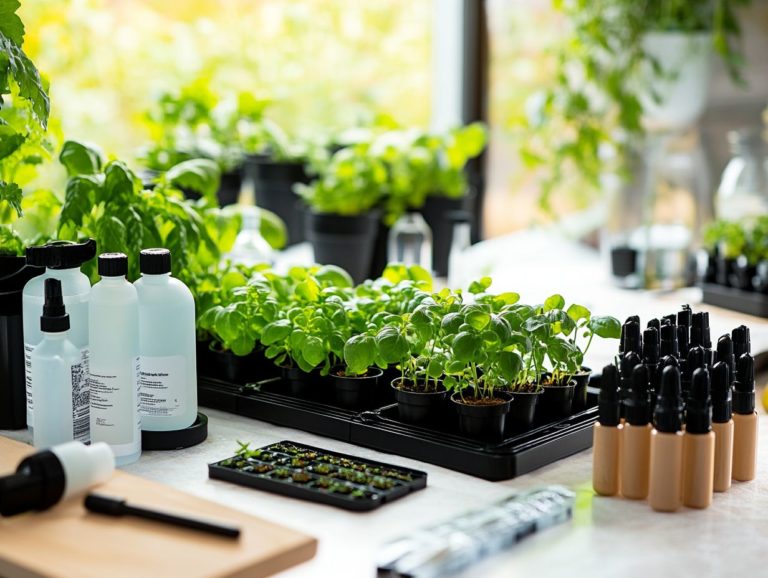How to Fix Nutrient Deficiencies in Hydroponics
In the realm of hydroponics, achieving optimal plant health depends on finding the perfect balance of nutrients. This includes addressing common nutrient deficiencies.
Recognizing nutrient deficiencies how they develop and the visual cues they present, such as leaf discoloration is essential for any dedicated hydroponic gardener. Their effects on growth are equally important.
This article delves into the common causes and consequences of nutrient shortages, nutrient imbalances, and nutrient toxicity. It offers effective methods for identifying and remedying these issues and strategies to prevent future deficiencies.
With insights tailored to specific plant types and their unique nutrient requirements, you’ll be empowered to cultivate vibrant, thriving crops in your hydroponic system.
Contents
- Key Takeaways:
- Unlocking Plant Health: Understanding Nutrient Deficiencies in Hydroponics
- Identifying Nutrient Deficiencies
- Solving Nutrient Deficiencies
- Preventing Nutrient Deficiencies
- Common Nutrient Deficiencies in Different Plants
- Frequently Asked Questions
- What is a nutrient deficiency in hydroponics?
- How can I identify a nutrient deficiency in my hydroponic system?
- How do I fix a nutrient deficiency in my hydroponic system?
- Can I prevent nutrient deficiencies in my hydroponic system?
- What are some common causes of nutrient deficiencies in hydroponics?
- How often should I check for nutrient deficiencies in my hydroponic system?
Key Takeaways:

- Regularly monitor and adjust nutrient levels to prevent deficiencies in hydroponic plants.
- Visual signs are important indicators of nutrient deficiencies in plants.
- Effective nutrient management, including the use of organic matter and foliar sprays, can solve and prevent nutrient deficiencies in hydroponics.
Unlocking Plant Health: Understanding Nutrient Deficiencies in Hydroponics
Grasping nutrient deficiencies in hydroponics is vital for maintaining plant health and optimizing yield. Your hydroponic setup relies on a carefully balanced mix of nutrients to deliver essential elements for growth, including nitrogen, phosphorus, and potassium.
However, various factors can lead to nutrient deficiencies that compromise chlorophyll production the green pigment in plants that helps with photosynthesis and overall vitality. When nutrient composition falls short, you might notice signs like leaf discoloration and stunted growth. These symptoms could indicate nitrogen deficiency or magnesium deficiency.
Identifying these deficiencies is essential for thriving plants! Adjusting nutrient levels accordingly enhances your hydroponic environment while cultivating a nutrient-rich growing medium. This supports robust plants and maximizes productivity, which is critical for achieving optimal yields. Understanding the role of micronutrients in hydroponics can further improve your results.
Causes and Consequences
The causes of nutrient deficiencies in hydroponics can arise from various factors, including nutrient imbalances, oversaturation, or even toxicity from salt buildup due to hard water or improper mixing of nutrients. This can lead to micronutrient deficiency.
One critical element that often goes unnoticed is the pH level of the nutrient solution, which should ideally remain between 5.5 and 6.5. If the nutrient solution pH strays too high or low, it can impede nutrient absorption, leading to deficiencies even when you have the right nutrients available, like Epsom salts for magnesium. To further enhance your hydroponic gardening, learn how to prevent nutrient burn in hydroponics.
High total dissolved solids (TDS) can limit nutrient uptake, resulting in symptoms like yellowing leaves or stunted growth. These issues are primarily due to potassium deficiency or calcium deficiency. Such deficiencies do more than just affect the appearance of your plants; they can substantially reduce yields, compounding the issue and impacting the overall productivity of your hydroponic systems. To avoid these problems, be aware of the top 10 nutrient mistakes in hydroponic gardening.
Identifying Nutrient Deficiencies
Identifying nutrient deficiencies is crucial for maintaining optimal plant health in hydroponics. Visual signs frequently reveal themselves through leaf analysis, helping detect issues like chlorosis or sulfur deficiency.
For example, chlorosis, characterized by the yellowing of upper leaves or discoloration of lower leaves, can indicate deficiencies in essential nutrients like nitrogen, phosphorus, and magnesium. By recognizing these symptoms early, such as leaf discoloration, you enable yourself to take corrective action before serious damage unfolds. This ensures your plants receive the necessary nutrients for robust growth and impressive yields.
Start monitoring your plants today for a healthier hydroponic garden!
Visual Signs and Symptoms

Visual signs and symptoms of nutrient deficiencies in hydroponics can vary significantly. Distinct patterns of leaf discoloration reveal specific nutrient problems.
For instance, if you notice chlorosis characterized by yellowing leaves it s often a sign of nitrogen or magnesium deficiency. This should prompt you to reassess your nutrient solution.
Typically, affected plants will show symptoms first in their older leaves, as they mobilize nutrients to support new growth. By recognizing these cues, you can make timely adjustments to your nutrient supply, ensuring that all essential elements are adequately available.
In a similar vein, an iron deficiency may manifest as interveinal chlorosis, where the leaf veins remain green while the surrounding tissue turns yellow. This serves as a critical indicator for managing nutrients. Such visual feedback is invaluable for maintaining plant vitality and optimizing yield, especially when avoiding issues like nutrient toxicity.
Solving Nutrient Deficiencies
Addressing nutrient deficiencies in hydroponics demands a comprehensive strategy that includes fine-tuning nutrient levels and integrating soluble nutrients along with nutrient-rich additives to support healthy plant growth.
Conducting regular analyses of the nutrient solution’s electrical conductivity (EC), which is a measure of how well the solution conducts electricity and indicates nutrient levels, and nutrient solution pH is crucial for identifying the precise adjustments required to tackle specific deficiencies.
For instance, you might consider incorporating Epsom salts to remedy magnesium shortages or other tailored nutrient additives that cater to your plants’ unique requirements. By meticulously calibrating the nutrient solution, you can restore balance and pave the way for optimal plant health and growth, ensuring that all key nutrients, including calcium and sulfur, are present.
Adjusting Nutrient Levels
Adjusting nutrient levels in hydroponics is essential for ensuring that your plants receive the perfect balance of nutrients, including potassium, for optimal growth while avoiding nutrient toxicity.
By employing precise techniques, you can effectively manage nutrient solutions that support healthy plant development. Monitoring the pH levels of these solutions is crucial, as it directly affects nutrient availability and uptake.
Regularly checking total dissolved solids (TDS) offers valuable insights into nutrient concentration, helping you maintain ideal growing conditions for your plants.
Understanding the importance of nutrient analysis enables you to make informed decisions, allowing you to tailor your approach to meet specific plant needs, such as addressing micronutrient deficiencies, and adapt to environmental changes. To enhance your knowledge further, check out this guide on how to mix hydroponic nutrients like a pro.
Consistent monitoring lets you catch nutrient problems early! Act fast to boost your plants’ health and yield. Spotting deficiencies or excesses early on paves the way for timely interventions that can enhance both yield and quality, which is especially critical in a hydroponic system. For more detailed guidance, check out this how to troubleshoot common hydroponic issues.
Alternative Nutrient Sources
Exploring alternative nutrient sources offers a sustainable strategy for addressing nutrient deficiencies while tailoring nutrient levels to meet the specific needs of various plants.
You can also use foliar sprays rich in micronutrients and vitamins to deliver essential nutrition directly to the upper leaves, ensuring quicker absorption and immediate benefits during critical growth stages, such as flowering phases.
This method boosts plant health dramatically! Especially in hydroponic systems where precise control over nutrient delivery is paramount, allowing for adjustments based on plant growth stages.
By incorporating organic matter like compost extracts, you can introduce beneficial microorganisms that enhance nutrient availability and foster a balanced ecosystem within your nutrient solution.
By integrating these alternative sources with traditional nutrient solutions, including soluble nutrients and nutrient-rich additives, you can expect improved growth rates, heightened resistance to pests and diseases, and optimized yield quality.
Preventing Nutrient Deficiencies

Preventing nutrient deficiencies in hydroponic systems starts with mastering effective nutrient management and understanding the precise nutrient mix necessary for thriving plant growth across different growing conditions.
By honing your understanding in these areas and recognizing common nutrient deficiencies, you can ensure your plants receive exactly what they need to flourish.
Best Practices for Nutrient Management
Implementing best practices for nutrient management is crucial for maintaining the health of your plants in hydroponic systems and preventing nutrient deficiencies.
Regular monitoring of the electrical conductivity (EC) and nutrient solution pH levels ensures that your plants receive the precise balance of nutrients they need to thrive. Understanding the specific nutrient mix required for different types of plants allows you to customize your approach, promoting optimal growth and development.
Adjusting nutrient levels based on the plants’ growth stages whether they are in the vegetative or flowering phases can significantly impact addressing nutrient deficiencies and maximizing yield. Additionally, knowing how to troubleshoot hydroponic system failures is crucial for maintaining a healthy garden.
Don’t forget that environmental factors like temperature, humidity, and light also play vital roles in plant health. Staying vigilant and adapting your nutrient strategies to meet the unique needs of your crops will set you up for success in managing nutrient mix. Additionally, being aware of nutrient deficiency symptoms in hydroponics can further enhance your gardening efforts.
Common Nutrient Deficiencies in Different Plants
Common nutrient deficiencies can vary greatly among different plant types in hydroponic systems, each possessing unique nutrient requirements such as calcium and phosphorus deficiencies. Knowing these differences can unlock your plants’ full potential!
Specific Nutrient Needs for Different Plant Types
Understanding the specific nutrient needs of different plant types is crucial for optimizing growth and preventing nutrient deficiencies in hydroponic systems.
Hydroponic systems support a diverse array of species, each with unique requirements for essential nutrients like nitrogen, phosphorus, potassium, calcium, and magnesium.
- If you re growing leafy greens, provide higher nitrogen levels to promote lush foliage.
- Fruiting plants such as tomatoes thrive on elevated potassium levels, which are key for enhancing fruit development and overall yield.
It’s essential to carefully monitor the pH and nutrient solution EC, as these factors can significantly affect nutrient uptake and plant health. By customizing nutrient mixes to meet the specific needs of each plant variety, you can boost productivity and ensure robust growth throughout the entire cultivation cycle.
Frequently Asked Questions

What is a nutrient deficiency in hydroponics?
A nutrient deficiency occurs when a plant doesn’t get enough of a specific nutrient. This can lead to stunted growth, discoloration, and health issues like nitrogen or potassium deficiency.
In hydroponics, different plants have unique nutrient requirements. For example, leafy greens need higher nitrogen levels for lush foliage, while fruiting plants like tomatoes thrive on potassium, which boosts fruit development.
How can I identify a nutrient deficiency in my hydroponic system?
Look closely at your plants’ leaves. Signs of a nutrient deficiency include discoloration, wilting, and unusual growth patterns.
How do I fix a nutrient deficiency in my hydroponic system?
To fix a deficiency, first identify the lacking nutrient. Then, adjust your nutrient solution by adding specific nutrients or modifying the nutrient mix.
Can I prevent nutrient deficiencies in my hydroponic system?
Yes! Regularly monitor nutrient levels in your solution and adjust as needed. Using high-quality nutrients and maintaining balanced pH levels are also critical.
What are some common causes of nutrient deficiencies in hydroponics?
Common causes include using poor-quality nutrients, incorrect pH levels, over or underfeeding, and inadequate water supply.
How often should I check for nutrient deficiencies in my hydroponic system?
Check your system at least once a week. Monitoring frequently helps you quickly catch and address any nutrient issues.






